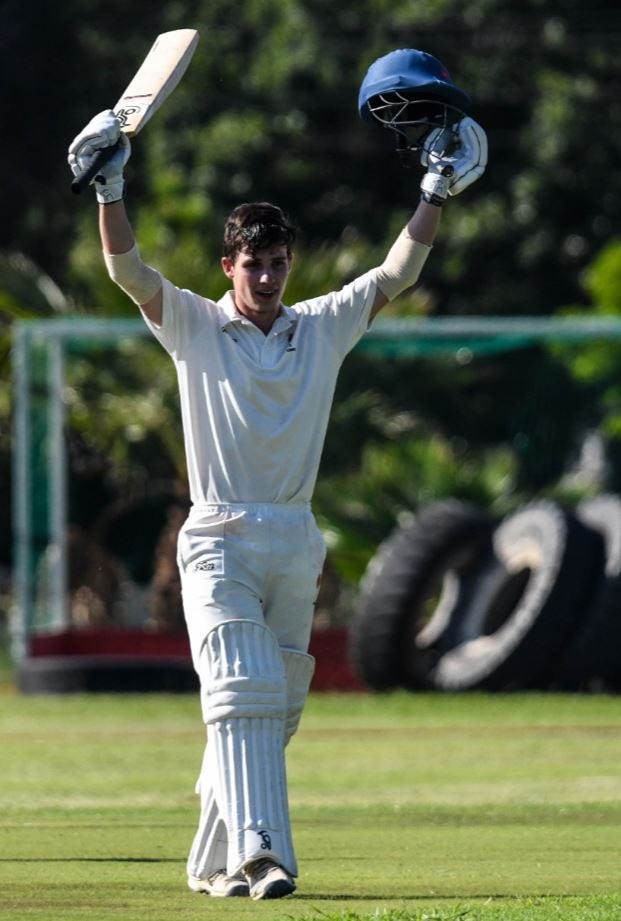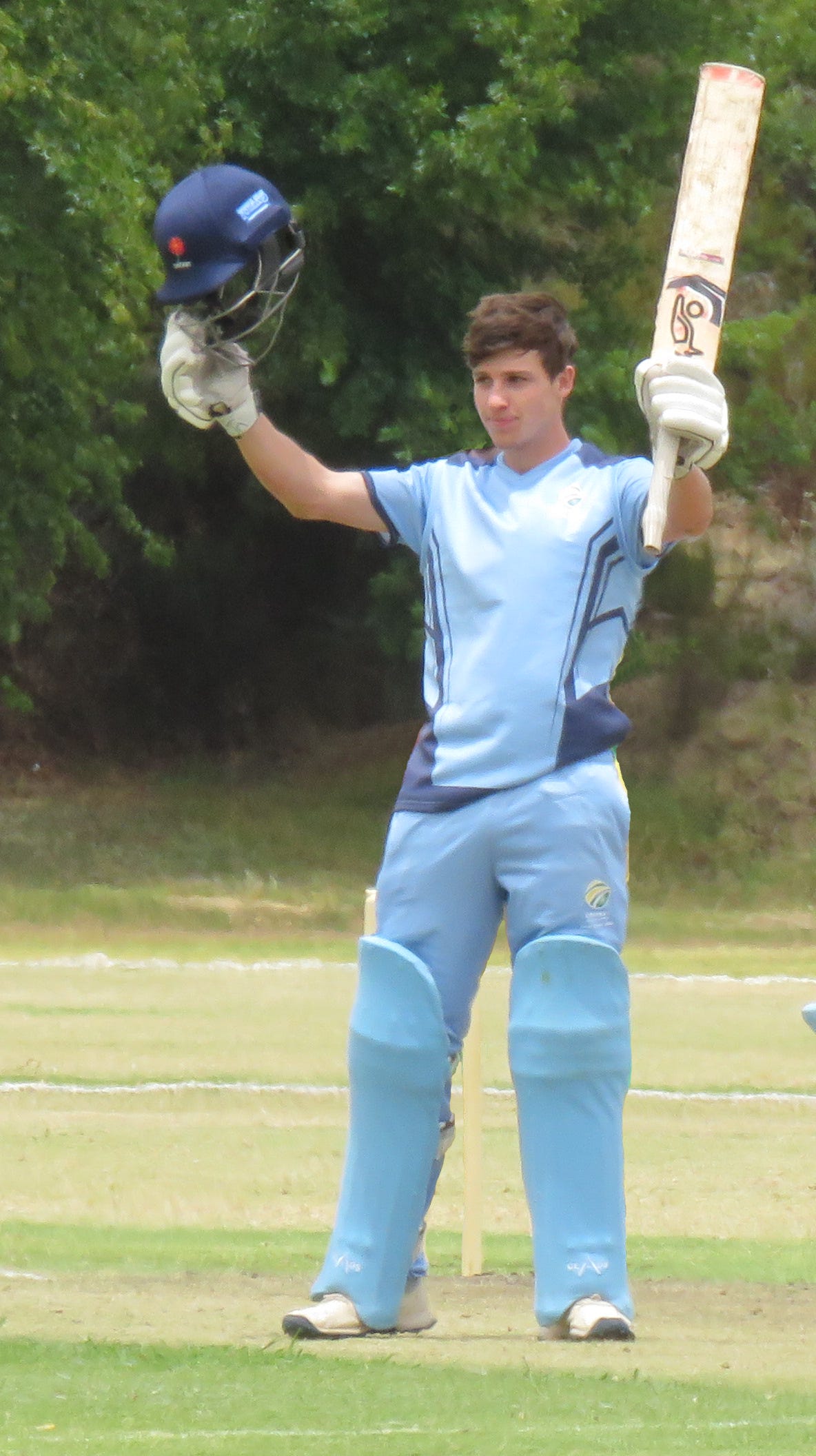Jordan Hermann strives to keep things simple when he has a bat in hand, “And I just remind myself ‘play what you see.’ The core of my philosophy is simplicity,” he says.
Hello, welcome to Stumped! If you are not yet a subscriber, join more than a thousand other professional athletes & ex-pros, coaches, commentators & analysts and casual sports fans that receive the newsletter in their inbox each week — it’s free:
Jordan Hermann hits a lot of fours. He scores more runs from fours than he does via singles, twos, threes and sixes combined. 51.72% of his runs across first-class cricket, List A and T20s come from fours.
He is from the school of thought that understands that ‘if you don't hit in the air, you can't get caught. That removes one mode of dismissal. Now they have to find another way to get you out.’ Of course, that’s not to say he doesn’t hit sixes.
Hermann scored his first four with a taped tennis ball on a greentop, surrounded by countless fielders: three slip fielders, three fielders in the covers, a fielder at point, another at backward point, two at long-on and two at long-off. Crammed in an average Pretoria East suburban backyard, the fielders were so close together it was easy to make one feel claustrophobic.
It was just as well that Jordan was not claustrophobic. He would not have done well at BevCricket, where the fields were so small that balls hit for fours rammed into the shins of spectators. Jordan hurt a lot of shins. He also forced a few spectators to duck each time he cleared the boundary with a six. “There was no time to get your eye in. We were all trying to get 25 or 30 runs in an over,” says Jordan.
Trees, garden chairs, flower bushes, Jordan’s father, his brothers, Rubin and Devon, and anything else they could find made up the fielders. Hermann’s batting had to be precise for him to pick the gaps. “It was important to my dad that we were all technically correct. He also always wanted us to play on the ground, so anything off the ground was out,” says Hermann.
Being the youngest of three did not earn him special treatment. The indefatigable Devon bowled to Jordan as he would bowl to their older brother, Rubin. When Devon took a breather, Rubin ran in with his medium pacers. There was laughter, screaming and tears as Jordan Hermann’s technique was tested.
Jordan's technique was also tested in action cricket where straight bat shots are encouraged. Playing good cover drives and on drives square of the wicket were also highly encouraged. The straight drive through extra cover, mid-off, mid-on and to cow corner are high-value shots. Aerial balls get you in trouble because even if the shot evaded the fielder, the ball often bounced off the netting for an easy catch.
“I faced a bit of criticism from some of the coaches at the time, they said to me action cricket was going to mess up the boys’ techniques because played in a certain way. I said it wasn’t because there was no need to change your game to play action cricket,” says Marius Hermann.
All the Hermann boys experienced growth spurts from around 17 years old. Before then, they were always the smallest ones in their cohort. Though they played junior rugby, until they were 11, their stature put rugby off the cards for them through their teens. They did play a bit of hockey, action cricket became their winter sport. For four years they played cricket all-year round; outdoor cricket in summer and indoor cricket in winter.
When Marius Hermann threw a plastic bat to a toddling Jordan Hermann, the youngster instinctively swung the bat lefty when his father rolled the ball to him. Jordan was right-hand dominant back then and still does everything right-handed. That is besides hockey, golf and cricket. Jordan plays soccer, tennis, badminton and everything else right-handed.
The first MCC coaching manual instructs batters to pick up a bat like they would pick up an axe. Marius, a self-confessed cricket fanatic who went on to get Cricket South Africa coaching badges, was aware of this. But, instead of correcting his son, he let him be. Marius had seen this behaviour in Rubin. It seemed to run in the family.
Five-time Major winner, Phil Mickelson, is right-handed but learned to play left-handed to mirror his father's right-handed swing. Mickelson feels that the 'reverse stance' has benefited his game. Gave him better control. "Especially short-game, where you’re essentially creating a slice backhand, it’s much easier to chip when your dominant hand is leading the stroke,” says Mickelson in Phil, the Alan Shipnuk-written biography.
The reverse stance does not just benefit golfers. According to a study, players like Jordan Hermann and David Miller, right-handers batting left-handed, and vice versa were far more effective.
Most batters place their dominant hand lower down the handle. However, with a reverse stance, the batter's dominant hand - the hand with the greatest dexterity - holds the top of the handle and plays a greater role in guiding and controlling the bat's path to hit the ball.
With a good strong top hand, batters hit over the cover region better. "Basically your top hand/arm drives the swing and supply’s the torque and stretch, the bottom hand/arm holds the swing in a strong and stable position until the swing is ready. The balance between the two is what creates a smooth and powerful swing," says batting coach and power-hitting consultant Julian Wood.
This Substack column exists thanks to patrons and readers that leave tips. Stumped! is wholly supported by Readers Like You. To keep the weekly posts coming and to keep the lights on here, consider leaving a tip or supporting monthly on Patreon. You won’t regret it!
Hermann was six when his father built the batting nets at the bottom of their backyard. There was nothing special about it. It was netting - three meters high and four meters wide - held together by cable ties surrounding a 12-metre concrete slab. During the rainy season, the nets were out of use for extended periods because a mud bath always formed where the concrete slab ended.
Finally, the flowers and other garden plants were also safe from being trampled upon. The distance of the nets from the house meant that the coaching, screaming and arguments did not disturb the rest of the Hermann household.
Even though ground shots were highly rated by the Hermann boys, boys will be boys and once in a while, they hit expansive sixes. The nets protected windows, theirs and their neighbours’, against errant shots. Pull and hook shots were now safe to play.
"One thing about Jordan, he never had issues against express pace or short-pitched deliveries from a young age," says Cobus Pienaar, Hermann’s coach at Waterkloof High School.
The concrete slab made the pitch a sporty one. It offered a lot of bounce. “Balls were flying around the jaw and it was chin music all the time, especially the hard new balls,” says Marius.
But, it was the creation of an all-weather and floodlit facility that changed everything. It had a full-length Flicx modular pitch. The facility took his father about five years to complete.
True to its billing, the Flicx pitch was less spicy, had a truer bounce and offered something for spin bowling. Hermann would be in there late into the night facing the bowling machine.
“My favourite shot is the one that goes down the ground,” says Jordan Hermann. He worked on it relentlessly in the facility. Hermann mastered the lofted cut that flies over point for six in the facility. His front and back foot cover drives, which make coaches weak at the knees were also perfected there.
Hermann would go from watching batters do innovative stuff on TV or on YouTube, to the facility to try out what he had seen. The possibilities were limitless. He was not always successful in his reenactments. He was usually alone - in the company of Riff Raff, their feisty and talkative African Grey parrot who had taken residence in the nets. Sometimes he was with his father.
Hermann joined Waterkloof High’s first team when he was in grade 10. He was good enough, but Pienaar identified a flaw in his technique. Hermann was susceptible to deliveries from right-arm bowlers bowling over the wicket. His defence needed fortifying and Hermann also needed to alter his set-up to help him open up a little bit more to increase his scoring options at the beginning of his innings. They also worked to revamp his technique to get him to play a lot straighter.
“Jordan was one of the most disciplined kids in his group. He works extremely hard on all aspects of his game and doesn’t leave any stone unturned. His attention to detail is magnificent,” says Pienaar.
Whatever they worked on at Waterkloof, Hermann carried it to their home facility as homework. "I grooved all my shots in there, and still do when I can today," says Hermann.
Whenever he got a shot right, Riff Raff exclaimed, “Oh, great shot!” At one stage, Riff Raff was exclaiming ‘great shot’ on every second shot Hermann made.
In November 2022, Jordan Hermann scored an unbeaten 187 runs. The runs put him into a very small club. He became one of three South African players with over 500 runs in their first six innings in first-class cricket. He is sandwiched between Pite van Biljon and AW Briscoe. In his debut season, Pite van Biljon racked up three centuries and a single half-century for an incredible 614 runs. In 1933, AW Briscoe - or Dooley, as he was known - hit two centuries and two half-centuries on his way to 523 runs.
It takes great temperament to pull off a run like that. Shannon Miller, a US gold medal gymnast, once said, “In the Olympic Games, everyone is talented. Everyone trains hard. Everyone does the work. What separates the gold medalists from the silver medalists is simply the mental game.”
Likewise for cricket. Dennis Lillee once told Mr Cricket, Mike Hussey, that cricket is 10% skill and 90% mental. The Australian pacer knew a thing or two about the subject. A broken back forced Lillee to take up a job as a bank clerk who also ran a cleaning company. To resurrect his career, Lillee found a PE teacher to train his body to full fitness. However, for him to be the iconic batter he became during his second coming, Lillee had to reprogram his own brain.
Glenn McGrath nudges the numbers to 20% skill and 80% mental. “Cricket is a game that obviously requires talent, but when talent is equal, as it so often is, the formula for success comes from strength of mind,” Steve Waugh chimes in.
Self-efficacy, as researchers call it, is a big part of how well a player does. Jordan Hermann knows a thing or two about the importance of self-efficacy and the other side of the coin. In his under-15 year, Hermann topped the run-scorers list with 1850 runs that featured four 100s and a double 100. However, he was not picked for the provincial team.
“Not being picked was very confusing to him,” says Marius Hermann. The snub led to a two-year period where he lost his way. He lost his mojo. He looked a million dollars at training and was crisp in his timing when he batted at home. But, none of it translated on the field.
“It stuck with me quite a bit. I think it hit me for a few years after that. It had me going, am I good enough? I was confused and didn't really know what I wanted to do with cricket. All I knew was that I wanted to play professionally, like my brother. But I had doubts,” says Hermann.
He reached rock bottom the year he failed to make the Under-17 provincial team. He was so low on confidence that he did not score a single century that year. But, change was on the horizon. After more than two years of uninspired performances, something snapped into place for Hermann. His family was on a holiday trip to Bredasdorp.
“Jordan and I broke into the Bredasdorp cricket nets,” says Marius Hermann. Father and son hopped over the waist-high fence that was in place to keep unauthorised people off the club premises. “If you couldn’t hop over the fence, you gould go through the gates. The gates were secured with a chain and padlock, but then the gates had a gap big enough for an adult to squeeze through into the nets.”
The pitches were cement slabs and they were surrounded by wire mesh. They were a far cry from their home facility or the nets he trained in at Waterkloof, yet, spending an afternoon out there facing throwdowns from his father did something to Jordan. It transformed him as if a switch was switched on in his brain. “Next year is my year. I'm going to show them I'm back,” Hermann told his father.
He did come back strong. Thanks to an altered mindset, Hermann caught fire. He put in performances that got him picked for everything. During the 2020 Cubs Week, Hermann broke Quinton de Kock and Andries Gouws’ jointly held record for most runs at a Cubs Week tournament. He scored 402 runs in five matches at an average of 100.5. In 2021 he scored the most centuries by a batter at Cubs Cricket.
The accrued confidence carried Hermann into his university career. He was so good that when the Titans needed a short-notice replacement for an absent Dean Elgar, Mandla Mashimbyi rang him up. Hermann announced himself in first-class cricket with a half-century. He settled for an unbeaten 50 because he ran out of partners to bat with. To show that he is not just a red-ball cricketer, Hermann announced himself in white-ball cricket with half-centuries on his List A and T20 debuts. He got into his groove early.
“Cricket is 90% mental,” Hermann echoes Lillee. He became more intentional in all aspects of his game. He has also become more consistent in practising visualization. He and Cobus Pienaar had always had chats about the perfect game, and how to get to that game.
“Visualization plays a massive part in that, especially in the modern game where players have a very good idea of who they play against and what the opposition strengths and weaknesses can be,” says Pienaar.
Herschelle Gibbs swears that visualization did wonders for his career. Other international batters have also shared that visualization has helped them succeed.
According to research, imagining yourself performing an action and moving both activate the motor cortex. Therefore visualization acts as simulated practice. Though the electrical impulses might be minor, through visualization, one is able to rewire new neural pathways within the brain. Where there are existing pathways, visualization helps in strengthening those pathways.
Hermann practised visualization the night before he scored his unbeaten 187 runs. “I have realised that I don’t do very well if I do not visualise my game the night before. I would say visualisation plays a huge role in my batting,” says Hermann.
At the moment, Jordan Hermann is visualizing a long and successful career for himself.









